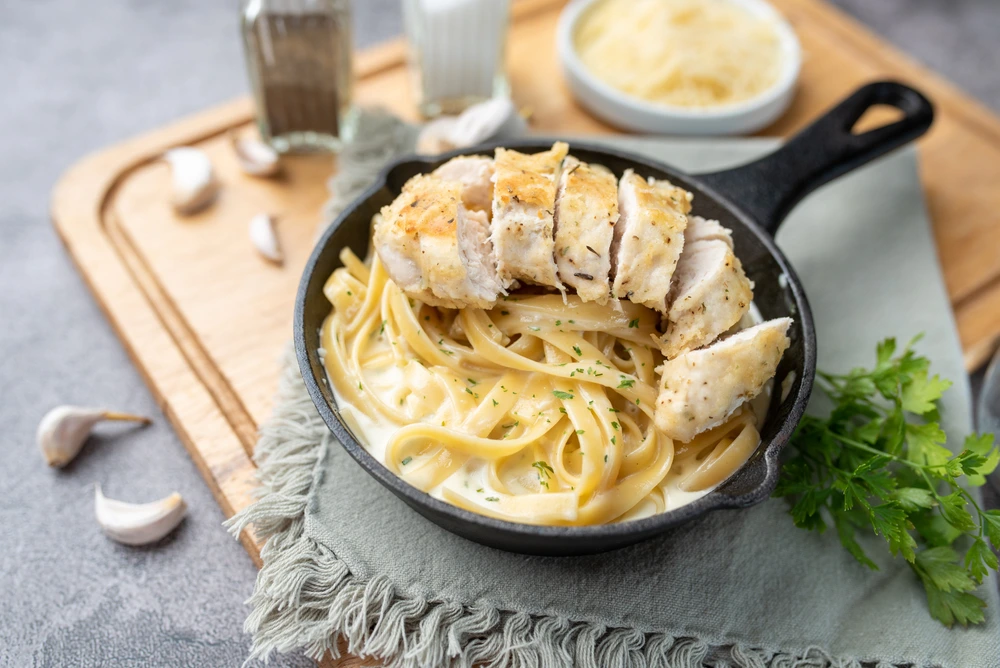
Pasta is a very popular Italian dish made in a variety of ways. And, Fettuccine Alfredo is a famous and delicious one.
Speaking of pasta, we think a common scenario happens with everyone. Whenever we cook pasta at home, we always make a generous amount. It’s maybe because we like it so much. Whatever the reason, we always end up with leftover pasta.
Leftover pasta is actually an advantage because you get to reheat it and have it for dinner the next day. However, the reheating process gets tricky and quickly turns into a disaster. But using some great techniques, you can master the art of reheating Fettuccine Alfredo.
Here you’ll find three excellent guides on how to reheat Fettuccine Alfredo. You won’t be disappointed!
Things to Know Before Reheating Fettuccine Alfredo
We know you must be excited to learn to reheat your Fettuccine Alfredo, but it is essential to know some things beforehand. Just go through these once and if you feel like you don’t need them, scroll down to the next part, reheating. But, trust us, it will help your pasta almost retain its original taste.
6 Things to Know Beforehand
- If you have made two different kinds of pasta, don’t mix them while storing. For example, you shouldn’t keep Fettuccine with Linguine together because they aren’t the same.
- You must store your Fettuccine Alfredo within 2 hours of cooking because leaving food out at room temperature for more than 2 hours can produce bacteria.
- Store it in a small airtight container that is not too deep. It will help not accumulate much moisture.
- You can store Fettuccine Alfredo in the fridge for 2 to 4 days.
- If you store it in the freezer, remember to bring it to room temperature before reheating. We advise you to thaw it for a day.
- Check if the pasta has gone bad. Usually, the appearance won’t help much, so try to taste it a bit. If it’s too sour or tangy, then it has gone bad.
3 Amazing Techniques of Reheating Fettuccine Alfredo
Fettuccine Alfredo is made with cheese, butter, and cream, making it much tastier. But, when stored in the fridge, the butter separates from the pasta and creates a grainy texture.
If you follow our reheating techniques correctly, you will be able to avoid all of these problems, and your pasta won’t also be gummy or dry. Now, when you reheat Fettuccine Alfredo, you will get a perfect texture, consistency, and flavor. We won’t make you wait anymore. Let’s get to the reheating methods!
1. In the Oven
Many people think reheating Fettuccine Alfredo in the oven will ruin and make it soggy and dry. We would like to say that if you do it right, no problem will occur. Reheating pasta in the oven yields great results; the best part is minimum cleaning.
Here are some things that you will need to reheat the pasta dish:
- Aluminum Foil
- Glass baking dish
- Milk or water
Steps to Reheat:
- Defrost your pasta for 24 hours.
- Don’t forget to preheat the oven for 10 minutes at 180℃ (350℉).
- While the oven is preheating, put your Fettuccine Alfredo in the glass baking dish. You can also use an oven-safe baking dish.
- Spread the pasta evenly on the baking dish. It will help to heat evenly.
- Depending on the amount of your food, pour two to three tablespoons of milk or water. It will add moisture and creaminess back to the dish.
- Now, cover the baking dish with aluminum foil. Make sure there is no gap because you need steam to warm the food. Moreover, it will also help retain moisture.
- Put the pasta into the oven and heat it for 10 minutes.
- Make sure you stir the food after 10 minutes; otherwise, it may burn.
- Then, warm it for another 5 to 10 minutes.
- Add your favorite topping, and serve or eat it hot.
2. In the Microwave
Microwave! The trusty kitchen appliance that we always use to heat everything. The food usually gets a bit weird, but hey, it does get the work done.
When you are really hungry, you definitely don’t have the patience to wait for 20 or 30 minutes for your food to heat up. That is when the microwave comes in handy.
But, there are some things you might want to know about reheating Fettuccine Alfredo in the microwave.
- The texture of your pasta will change because it can get overcooked. You may have to chew it for an eternity.
- The meat in the pasta will get dry and hard to chew.
- The sauce will curdle and solidify, making the dish harder to bring back to its original form.
Okay, now listen to us. It’s fine if you are in a hurry and want to use the microwave to heat food. You can easily solve the problems above with just a few tips and tricks. Believe us; it helped us a lot when we were in a hurry.
So, without further ado, let’s move on to the steps for reheating Fettuccine Alfredo in the microwave.
Steps to Reheat:
- Thaw your Fettuccine Alfredo beforehand.
- Place it in a microwaveable bowl or dish.
- If you want, you can microwave it for a minute and stir at first.
- Then, cover your bowl with plastic wrap and make two holes so the steam can escape. It will help retain moisture.
- Add white sauce and grated Parmesan cheese on top.
- Microwave the bowl for a minute.
- Pour a tablespoon or two of milk because water may not be your best friend here.
- Microwave again for a minute, take it out, and stir.
- Repeat this process for 10 minutes.
- Take it out and serve your pasta hot.
3. On the Stove Top
If you don’t have any of the above appliances, there is always a stove. Yeah, it might be a little time-consuming and need more supervision, but this technique also works as well as the others.
Moreover, there are two techniques for heating Fettuccine Alfredo on the stovetop. However, we think one is more accessible than the other. Now, it depends on you which one to use. So, onto the steps!
Steps to Reheat: Using a Saute Pan
- Get yourself a saucepan or a saute pan and put the Fettuccine Alfredo.
- Put the saucepan on the stove on medium heat.
- Stir the pasta gently to avoid any breakage.
- Then add cream or sauce to the pasta.
- Turn the heat lower to a medium-low level.
- Stir continuously unless you want it to burn.
- When you see the pasta getting creamy, you are done.
- Take off the heat and enjoy.
Steps to Reheat: Using a Hot Water Bath
- You will need two pots for this method. One is for water and the other for your Fettuccine Alfredo.
- Put the pot with water on the stove and then place the other pot on top. It will be much easier if the pasta pot has a handle and is slightly smaller.
- Keep the stove’s heat on a medium level, so the water doesn’t start boiling. It has to be on a simmering level.
- Keep stirring the pasta and add a tablespoon of milk or cream.
- Remove the pasta pot when it is heated.
- Serve while it’s hot.
What is the Best Way to Reheat Fettuccine Alfredo?
Wow! Lots of great techniques for reheating your favorite pasta dish. But, there is the question of which one is the best.
You already know all the methods now, so we can figure out which is the best together. First, there is the oven, which is not exactly fast, but it is the easiest and yields a perfect result every time. There is also the advantage of not having to clean many dishes.
The second is the microwave method. It is fast and easy, but there are a lot of possibilities of messing up your Fettuccine Alfredo. It could easily solidify or separate if you aren’t careful with the process.
Third and last is the stovetop method. The two techniques for reheating on the stovetop are pretty straightforward. Moreover, the food will not curdle and heat evenly. You can also add meat to it later. But it will take some time and will require complete supervision. You don’t want burnt pasta, right?
So, which is the best? We think all the methods are pretty helpful and easy. Each applies to a different person and depends on how one’s situation is. We believe it depends on the person to choose which works better for them. But we will say that the oven and stove top method will give the best results in reheating Fettuccine Alfredo.
Tips to Always Follow for all Methods
All methods work great but to bring the original flavor back to the dish, use a little bit of lemon juice for some freshness. You can also add Italian seasonings or a bit of garlic to add extra flavor. And you must not forget to add cream or milk to retain the dish’s creaminess.
Is It Hard to Reheat Instant Pot Fettuccine Alfredo?
What? Who told you that reheating instant pot Fettuccine Alfredo is hard? As easy as it is to make, you can quickly reheat it in a couple of steps. It works the same!
Stored instant pot Fettuccine Alfredo may get dry after a day in the fridge, but you can always add a little milk or cream to it while heating. It will bring back the flavor as well as make it more creamy.
How to Reheat Chicken Alfredo?
Fettuccine Alfredo with chicken is chicken Alfredo. So, there are no extra steps to take for reheating it. If you want to reheat your chicken Alfredo, just follow the steps above.

But to make sure your already cooked chicken doesn’t become too dry and chewy, we have some great tips.
- Whatever method you use, when you have any meat in your dish, use a low temperature to warm the food.
- If your chicken chunks are big, you can pick them up and fry them with butter in a saucepan. Then add them to your warm Fettuccine Alfredo before you eat.
- Sprinkle some water on the chicken so that they hold onto moisture.
- When reheating, add more sauce or cream than needed so that it gets into the chicken and keeps it juicy.
Were We a Bit Helpful?
Fettuccine Alfredo is a great leftover dish. We would be sad if it weren’t reheated properly. But, now that you know all the methods of reheating it, you can enjoy it later in its original form.
We hope we did a good job of rescuing your food. If you want more food rescue tips and tricks, just explore the website. Have a great day!

Lorena Davalos joined our team during the Lockdown of worldwide pandemic. She is a nutrition expert and has a degree in this subject. Lorena surely knows her onion! She was looking for a platform where she could blend her expertise with commonly asked questions.
